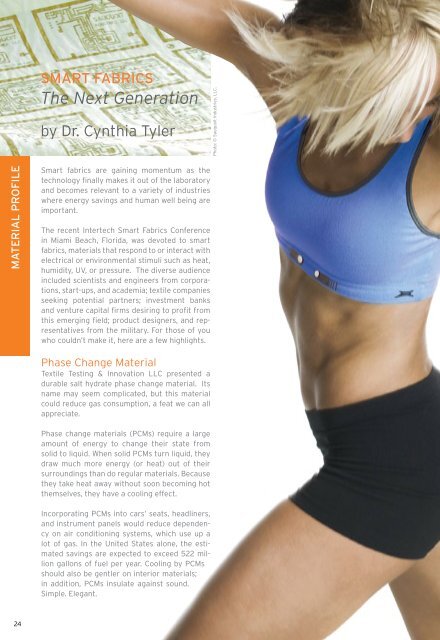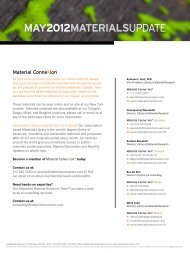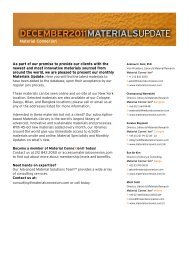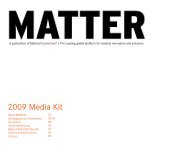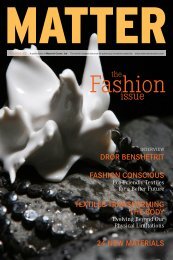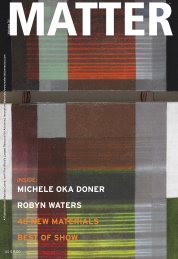48 new materials - Material ConneXion
48 new materials - Material ConneXion
48 new materials - Material ConneXion
You also want an ePaper? Increase the reach of your titles
YUMPU automatically turns print PDFs into web optimized ePapers that Google loves.
MATERIAL PROFILE<br />
24<br />
SMART FABRICS<br />
The Next Generation<br />
by Dr. Cynthia Tyler<br />
Smart fabrics are gaining momentum as the<br />
technology finally makes it out of the laboratory<br />
and becomes relevant to a variety of industries<br />
where energy savings and human well being are<br />
important.<br />
The recent Intertech Smart Fabrics Conference<br />
in Miami Beach, Florida, was devoted to smart<br />
fabrics, <strong>materials</strong> that respond to or interact with<br />
electrical or environmental stimuli such as heat,<br />
humidity, UV, or pressure. The diverse audience<br />
included scientists and engineers from corporations,<br />
start-ups, and academia; textile companies<br />
seeking potential partners; investment banks<br />
and venture capital firms desiring to profit from<br />
this emerging field; product designers, and representatives<br />
from the military. For those of you<br />
who couldn’t make it, here are a few highlights.<br />
Phase Change <strong>Material</strong><br />
Textile Testing & Innovation LLC presented a<br />
durable salt hydrate phase change material. Its<br />
name may seem complicated, but this material<br />
could reduce gas consumption, a feat we can all<br />
appreciate.<br />
Phase change <strong>materials</strong> (PCMs) require a large<br />
amount of energy to change their state from<br />
solid to liquid. When solid PCMs turn liquid, they<br />
draw much more energy (or heat) out of their<br />
surroundings than do regular <strong>materials</strong>. Because<br />
they take heat away without soon becoming hot<br />
themselves, they have a cooling effect.<br />
Incorporating PCMs into cars’ seats, headliners,<br />
and instrument panels would reduce dependency<br />
on air conditioning systems, which use up a<br />
lot of gas. In the United States alone, the estimated<br />
savings are expected to exceed 522 million<br />
gallons of fuel per year. Cooling by PCMs<br />
should also be gentler on interior <strong>materials</strong>;<br />
in addition, PCMs insulate against sound.<br />
Simple. Elegant.<br />
Photo: © Sauquoit Industries, LLC.


